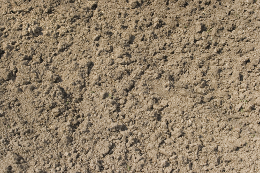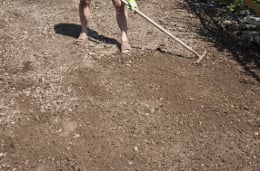How to Prepare your Soil for a Buffalo Grass Seed Lawn

An important step before planting your Buffalo grass seed is to prepare and grade the soil. No soil is perfect, especially the poor-draining, low quality sub-soils usually exposed by new construction. Taking the extra time and effort to improve your soil before seeding your Buffalograss seed lawn will reduce your water usage and save you money for years to come.
Not only will a poor soil cost you extra money keeping your lawn watered, but it also makes for a poor looking lawn. As a rule: healthy grass lawns grow in healthy soil. Many people dump loads of fertilizer onto their lawn (another extra cost) to make it as green as possible and mask their soil’s shortcomings. But this is a short-term, habit-forming fix. A well-prepared soil, combined with the best Buffalo grass seed varieties available, will save you time and money and give you the best chance at a picture-perfect lawn.
A good soil is well-structured. The better the structure the easier it is for water to absorb and percolate deep into the soil profile. Clay soils are dense and compact easily, making them slow to absorb water and nutrients. This makes them prone to losing water to runoff and evaporation before much of it gets down to the roots. Sandy soils allow water to move through the soil too quickly and evaporate from the soil too easily. In a well-structured soil, water is held deeper in the soil and is protected from summer evaporation. This encourages your Buffalo grass lawn’s roots to grow down deeper than they would in a poor soil, giving them access to additional water and nutrients which are out of reach of shallower rooted plants.
Healthy soils need various components such as organic matter, diverse particle sizes and enough pore space to hold oxygen and water. Poor soils suffer from a shortage of most or all of these components, but organic matter is the solution to every one of them. Decomposing organic matter provides nutrients for your grass seed and also increases the diversity of soil particles (instead of the evenness of a pure-sand or pure-clay soil). The various particles from the added organic matter create a matrix of space between the soil particles that allow water and oxygen in and give roots room to grow. Taking extra steps before you plant your Buffalograss seeds will produce a healthy soil, giving you a thick, lush lawn needing less water and fertilizer.
- Before planting your Buffalo grass seed, rototill the top six inches of your existing soil. This adds oxygen and breakups any compacted areas that restrict water absorption and root growth.
- Till in organic matter such as black topsoil, compost, shredded yard waste (leaves, grass clippings, etc.) or an organic matter-based, slow-release fertilizer.
- Add any additional soil amendments as suggested by your local county extension agent. (Your local agent may recommend you get your soil analyzed first. Follow their instructions on where and how to have your soil tested.)
 Once you have improved the organic matter content of your soil, it is time to install your sprinkler system. After installation, fill in the trenches housing the sprinkler pipe and use a rake to level the entire area, removing large rocks and other debris. Finally, use a lawn roller filled with water to firm the soil. The roller needs to be filled at least halfway with water to provide the correct weight. Be careful not to add too much water to the roller or roll any area too many times, as this will compact the soil and prevent proper water infiltration and drainage.
Once you have improved the organic matter content of your soil, it is time to install your sprinkler system. After installation, fill in the trenches housing the sprinkler pipe and use a rake to level the entire area, removing large rocks and other debris. Finally, use a lawn roller filled with water to firm the soil. The roller needs to be filled at least halfway with water to provide the correct weight. Be careful not to add too much water to the roller or roll any area too many times, as this will compact the soil and prevent proper water infiltration and drainage.
After your lawn has established itself, it is important to maintain the healthy, organic-rich soil you have created. Remembering that organic matter and soil structure are two of the main keys to a healthy soil, every year take some additional steps to maintain your soil’s health:
- When mowing your lawn, don’t bag the clippings. Instead, set your lawnmower to its ‘mulch’ setting. Lawn clippings provide your Buffalograss with a steady input of organic matter throughout the growing season that will slowly decompose on the soil surface.
- Have your lawn aerated at least once a year (twice—fall and spring—if you have high-clay soils). Aeration breaks-up compacted soils, opens up space for new growth, creates a pathway for oxygen to enter the soil, helps thatch and clippings to decompose and allows water to infiltrate into the soil easier.
- Top-dress your lawn with black topsoil, compost or any other fine-particle organic matter that can be easily worked down to the crown of the grass. Even sand—either alone or blended with topsoil or compost—can be a helpful top-dressing to improve soil structure (especially in high-clay soils). Top-dressing your lawn shortly after aerating, before the holes have had time to close back up, can be particularly beneficial. (Note: It is important never to top-dress a light sandy soil with a heavier top-dressing. This will cause soil interfacing and restrict root depths.)
Taking these extra steps create to produce and maintain a healthy soil will turn your Buffalo grass seeds into a thick, lushBuffalo grass lawn, needing less fertilizer and water for the life of your lawn.
